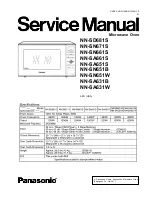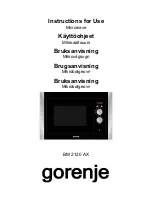
Explanation of the Auto Sensor Cooking process
1. During the first 10 second period there is no microwave
activity. When calculating the T2 time by using the
formula below make sure this 10 seconds is subtracted
from the T1 time. In other words, T1 time starts at the
end of the 10 second period.
2.
T1 time
The total amount of time it takes the microwave
oven to switch to T2 time after the 10second period.
3.
T2 time
When the steam escapes from the cooking
container placed in the oven, the steam sensor detects
it and the microprocessor calculates the balance of
cooking time. This T2 time is then shown in the display
and begins counting down.
Balance of cooking time (T2 time)
The balance of cooking time which is called T2 time,
can be calculated by the following formula.
T2 time (in sec.) = T1 time X K factor - 150
NOTE:
Remember, the T1 time starts after the 10 second
period. The coefficient K is programmed into the
microprocessor memory and they are listed in the
following tables along with the P1 and P2 powers.
NOTE:
When "More" or "Less" pad is selected, the K factor
varies resulting in T2 time to be increased or decreased.
Example of calculating the T2 time
Example 1: If the T1 time is measured to be 2 minutes and
40 seconds after the 10 second period.
T2 = T1 × K - 150 sec.
= 2 min. and 40 sec. × 1.1 - 150 sec.
= 160sec. × 1.1 - 150 sec.
= 26 sec.
Category
P1
Power
P2
Power
K Factor
Standard
Oatmeal
MEDIUM-HIGH MEDIUM-HIGH
0.4
2.5. Sensor reheat (Only for sensor
models)
Auto Sensor Reheat is a quick and easy way to reheat
refrigerated and room temperature foods.
Simply press the reheat pad. There is no need to select power
level and cooking time.
NOTE:
The Auto Sensor Reheat process is similar as Auto Sensor
Cooking process.
Balance of cooking time (T2 time)
The balance of cooking time which is called T2 time, can be
calculated by the following formula.
T2 time (in sec.) = T1 time X K factor - 150
NOTE:
Remember, the T1 time starts after the 10 second period.
The coefficient K is programmed into the microprocessor
memory and they are listed in the following tables along
with the P1 and P2 powers.
NOTE:
When "More" or "Less" pad is selected, the K factor varies
resulting in T2 time to be increased or decreased.
Example of calculating the T2 time
Example 1: If the T1 time is measured to be 2 minutes and
40 seconds after the 10 second period.
T2 = T1 × K - 150 sec.
= 2 min. and 40 sec. × 1.1 - 150 sec.
= 160sec. × 1.1 - 150 sec.
= 26 sec.
Category
P1
Power
P2
Power
K Factor
Standard
Sensor Reheat MEDIUM-HIGH MEDIUM-HIGH
1.1
2.6. Steam sensor and digital
programmer circuit (Only for
sensor models)
In order to determine if the steam sensor function of the digital
programmer circuit is working, do the following test.
1. Place a water load (150 cc) in the oven.
2. Tap Sensor Reheat pad.
3. Tap Start pad.
4. Steam Sensor detects steam about 1.5 to 4 minutes after
the Start pad is tapped.
5. T1 time cooking automatically switches to remaining time
for cooking (T2).
6. The remaining cooking time (T2) appears in display
window. If the following cooking time appears, Steam
Sensor function is normal.
T1 TIME
T2 TIME (Remainingcooking time)
50 Sec. ~ 12 Min.
0 Sec. ~ 10 Min.42 Sec.
2.7. Thermistor
The thermistor that is attached to the magnetron detects the
temperature of the magnetron and will stop magnetron
operation when overheating is detected. A normal thermistor´s
resistance is 35K
Ω
to 110K
Ω
for an ambient temperature range
of 10-30 degree C.
8
NN-SD681S / NN-SN671S / NN-SN661S / NN-SA661S / NN-SA651S / NN-SN651B / NN-SN651W / NN-SA631B / NN-SA631W
Содержание NN-SA631B
Страница 2: ...2 NN SD681S NN SN671S NN SN661S NN SA661S NN SA651S NN SN651B NN SN651W NN SA631B NN SA631W ...
Страница 3: ...3 NN SD681S NN SN671S NN SN661S NN SA661S NN SA651S NN SN651B NN SN651W NN SA631B NN SA631W ...
Страница 38: ...38 NN SD681S NN SN671S NN SN661S NN SA661S NN SA651S NN SN651B NN SN651W NN SA631B NN SA631W ...
Страница 40: ...40 NN SD681S NN SN671S NN SN661S NN SA661S NN SA651S NN SN651B NN SN651W NN SA631B NN SA631W ...









































